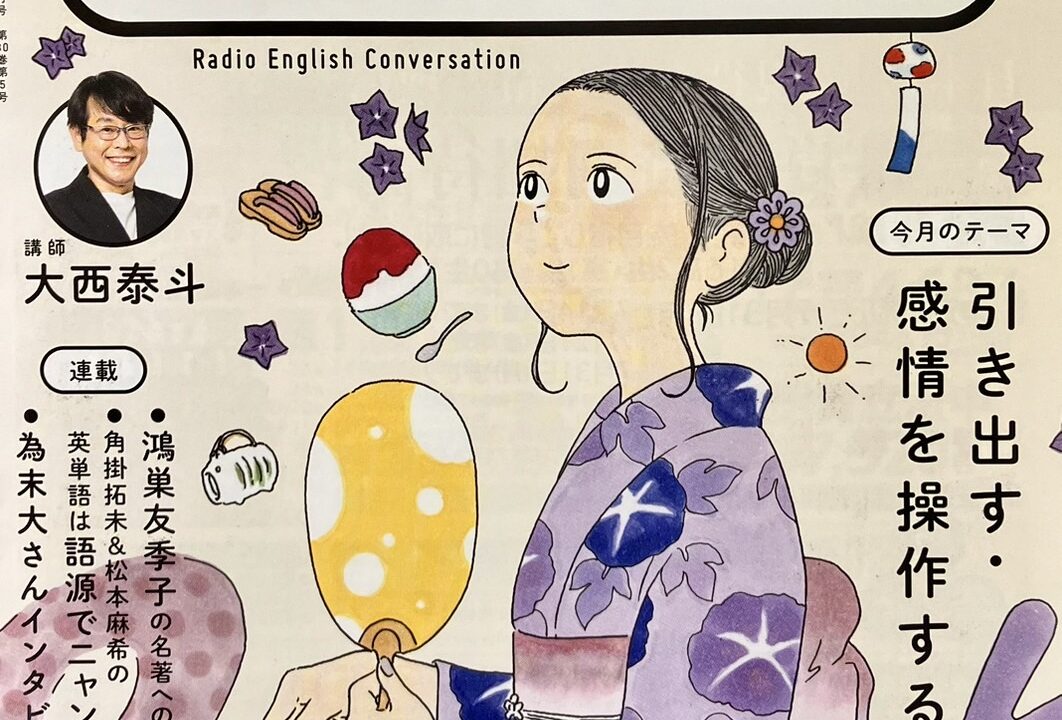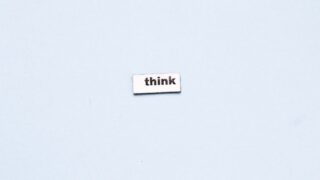【ラジオ英会話】Lesson 86 発言タイプ:引き出す⑤「判断」を引き出す – August 7 and 14 Monday, 2023

August 7 and 14 Monday, 2023
Lesson 86 発言タイプ:引き出す⑤「判断」を引き出す
☆Words & Phrases
**come along:
How is the painting coming along?
**track:
Am I on the right track?
Well, you need to use more water when you mix the colors.
**light color: ⇔ dark color:
It’s best to start with lighter colors first.
**be supposed to ~:
Oh, I thought I was supposed to paint the dark colors first.
**opposite:
Watercolors are the opposite.
**get the hang of ~:
You’ll get the hang of it.

☆Grammar and Vocabulary
① It‘s best to start with lighter colors first.
it ~ to…
この文では it ~ to… の形が使われている。it は 「それ」と訳されることもあるが、「指す」単語ではなく「受ける」単語。
この文で話し手は、心の中の状況 を It’s best(最善なのです)と始めている。このままでは何が最善なのかが伝わらないため、急いで to不定詞以降での内容を説明している。
it ~ to… は、まずで文を始めてしまい、その内容を後出しにする形。
② That’s what you do when you use oil paints.
説明型でwh節を用いる
be動詞を使った説明型(SVC)の文。be動詞の後ろの説明語句が、ここでは wh節 what you do となっている。wh節は疑問形を伴わない文の部品。「あなたが何 をする(のか)=あなたがすること」 両用の形。
疑問形を伴う wh疑問文 What do you do?(あなたは何をするのですか?)と明確に区別すること。
友だち追加でLINEにラジオ英会話で学んだフレーズを実際のビジネスシーンで使うための方法、そして放送のまとめが届きます。
☆Typical Expressions
Am I on the right track?
track は 「道・軌道」
この文は、正しい道筋の上にあるのか — 考え方・やり方の正しさについて判断を求める文。
① I entered my account number here. Is that correct?
→ Is that correct? という確認表現自体は難しくはないが、ここではそこに持ち込むための流れに注意。「確認を要する内容 → 判断を求める」の流れ。
② I tried a new hairstyle. What do you think?
→ What do you think? は意見を引き出す万能表現。判断も意見の一部なので使うことができる
③ Are we on the same page [on the same wavelength]?
→ on the same page は「同じ考え・ 認識にある」で、「同じページを開いている」から。
on the same wavelength(同じ波長にいる)も同様に使われる。
④ Are you comfortable with that?
→ comfortable は 「居心地がよい→賛成・異論がない」を意味している。提案などへの同意を尋ねる際使われるフォーマルな表現。
この文は、yes/noで簡単に割り切れそうにない微妙なケースでよく使われる。「居心地」 を聞いているのだから。
★Practice
D: Okay everyone. It’s time for the practice part of today’s lesson. Are you ready to go?
R: Here I want you to notice which words are being emphasized. These are the important words in the sentence, okay? Keep that in mind as you practice.
D: All right. Listen closely, and repeat after us,
– I entered my account number here. Is that correct?
Let’s try one more time,
– I entered my account number here. Is that correct?
R: Okay, next one,
– I tried a new hairstyle. What do you think?
Do you hear how I emphasized, “think”? That’s the important word for me here. So, let’s try one more time,
– I tried a new hairstyle. What do you think?
D: I think it’s lovely.
R: Thank you!
D: All right. Let’s continue,
– Are we on the same page?
Now let’s try that with the “wavelength” instead.
– Are we on the same wavelength?
R: And one last example,
– Are you comfortable with that?
Let’s do one more time,
– Are you comfortable with that?
Excellent work, everyone!
D: Roza, I think everyone did a great job today. Are we on the same page?
R: We are! Indeed.
D: All right. Great job, everyone.
☆Typical Expressions in Action
①私のエッセーをちょっと見て。 私は正しい道筋にありますか?
**take a look at ~:
②誤解があるような気がするのですが。私たちは同じ認識でしょうか?
**feel like ~:
③私たちの計画は予算の増額を必要とします。あなたはそれでよろしいでしょうか?
**require:
**budget:
★Ending
O: Hey guys. Are we on the same page?
R: Well, I’m on page 35.
D: Page? You guys have pages?
August 7 and 14 Monday, 2023
Lesson 86 発言タイプ:引き出す⑤「判断」を引き出す
(日本語訳・解説付き)
☆Words & Phrases
**come along:(作業が)進む
How is the painting coming along?
絵の進み具合はどうですか?
※How is ~ coming alone?(~はどう進んでいますか?) は、何かの進捗状況を尋ねる定番表現です
**track: 道、軌道
Am I on the right track?
私は正しい道の上にいますか?=こんな感じであっていますか?
Well, you need to use more water when you mix the colors.
ええ、絵の具を混ぜるときは、あなたはもっと水が必要です=絵の具を混ぜるときにはもっと水を足した方がいいね。
※ need to ~ はカタマリとして覚えておきましょう!need は「(~することがこれから)必要」なので、矢印(→)のイメージを持つ to とベストコンビネーションです!
**light color: 淡い色 ⇔ dark color: 濃い色
It’s best to start with lighter colors first.
まずより淡い色から始めることが最善です。
**be supposed to ~: ~することになっている
Oh, I thought I was supposed to paint the dark colors first.
あら、私は最初に濃い色を塗るものだと思っていました。
**opposite: 反対/逆のこと
Watercolors are the opposite.
水彩画ではその逆です。
**get the hang of ~: ~のコツをつかむ
You’ll get the hang of it.
あなたはそのコツをつかむでしょう=その分かるよ
※oil painting(油絵)、watercolor painting(水彩画)を覚えておきましょう!

☆Grammar and Vocabulary
① It‘s best to start with lighter colors first.
まずより淡い色から始めることが最善です。
it ~ to…
この文では it ~ to… の形が使われている。it は 「それ」と訳されることもあるが、「指す」単語ではなく「受ける」単語。
この文で話し手は、心の中の状況 を It’s best(最善なのです)と始めている。このままでは何が最善なのかが伝わらないため、急いで to不定詞以降での内容を説明している。
it ~ to… は、まずで文を始めてしまい、その内容を後出しにする形。
② That’s what you do when you use oil paints.
それは油絵の具を使うときにすることです。
説明型でwh節を用いる
be動詞を使った説明型(SVC)の文。be動詞の後ろの説明語句が、ここでは wh節 what you do となっている。wh節は疑問形を伴わない文の部品。「あなたが何 をする(のか)=あなたがすること」 両用の形。
疑問形を伴う wh疑問文 What do you do?(あなたは何をするのですか?)と明確に区別すること。
友だち追加でLINEにラジオ英会話で学んだフレーズを実際のビジネスシーンで使うための方法、そして放送のまとめが届きます。
☆Typical Expressions
Am I on the right track?
私は正しい道筋にありますか?
track は 「道・軌道」
この文は、正しい道筋の上にあるのか — 考え方・やり方の正しさについて判断を求める文。
① I entered my account number here. Is that correct?
私はここに私のアカウントナンバーを入力しました。これで正しいでしょうか?
→ Is that correct? という確認表現自体は難しくはないが、ここではそこに持ち込むための流れに注意。「確認を要する内容 → 判断を求める」の流れ。
② I tried a new hairstyle. What do you think?
新しい髪型にしてみました。どう思いますか?
→ What do you think? は意見を引き出す万能表現。判断も意見の一部なので使うことができる
③ Are we on the same page [on the same wavelength]?
私たちは同じ考えでしょうか?
→ on the same page は「同じ考え・ 認識にある」で、「同じページを開いている」から。
on the same wavelength(同じ波長にいる)も同様に使われる。
④ Are you comfortable with that?
あなたはそれでよろしいでしょうか?
→ comfortable は 「居心地がよい→賛成・異論がない」を意味している。提案などへの同意を尋ねる際使われるフォーマルな表現。
この文は、yes/noで簡単に割り切れそうにない微妙なケースでよく使われる。「居心地」 を聞いているのだから。
★Practice
D: Okay everyone. It’s time for the practice part of today’s lesson. Are you ready to go?
R: Here I want you to notice which words are being emphasized. These are the important words in the sentence, okay? Keep that in mind as you practice.
D: All right. Listen closely, and repeat after us,
– I entered my account number here. Is that correct?
Let’s try one more time,
– I entered my account number here. Is that correct?
R: Okay, next one,
– I tried a new hairstyle. What do you think?
Do you hear how I emphasized, “think”? That’s the important word for me here. So, let’s try one more time,
– I tried a new hairstyle. What do you think?
D: I think it’s lovely.
R: Thank you!
D: All right. Let’s continue,
– Are we on the same page?
Now let’s try that with the “wavelength” instead.
– Are we on the same wavelength?
R: And one last example,
– Are you comfortable with that?
Let’s do one more time,
– Are you comfortable with that?
Excellent work, everyone!
D: Roza, I think everyone did a great job today. Are we on the same page?
R: We are! Indeed.
D: All right. Great job, everyone.
☆Typical Expressions in Action
①私のエッセーをちょっと見て。 私は正しい道筋にありますか?
Take a look at my essay. Am I on the right track?
**take a look at ~: ~をちょっと見る
②誤解があるような気がするのですが。私たちは同じ認識でしょうか?
I feel like there’s been a misunderstanding. Are we on the same page?
**feel like ~: ~であるような気がする
③私たちの計画は予算の増額を必要とします。あなたはそれでよろしいでしょうか?
Our plan requires an increased budget. Are you comfortable with that?
**require: 要求する、必要とする
**budget: 予算
★Ending
O: Hey guys. Are we on the same page?
R: Well, I’m on page 35.
D: Page? You guys have pages?
『ラジオ英会話』がビジネスシーンでの「英語雑談」に最強な理由
名古屋駅前にあるビジネス英語&仕事での英語雑談力をつけるための「名古屋BEGビジネス英会話ジム」
営業時間:平日 9:00~22:00 土曜日 9:00~19:00(日祝休み)
〒450-0002 愛知県名古屋市中村区名駅2丁目40-16 名駅野村ビル 5階
お電話でのお問い合わせ 080-6900-1868



